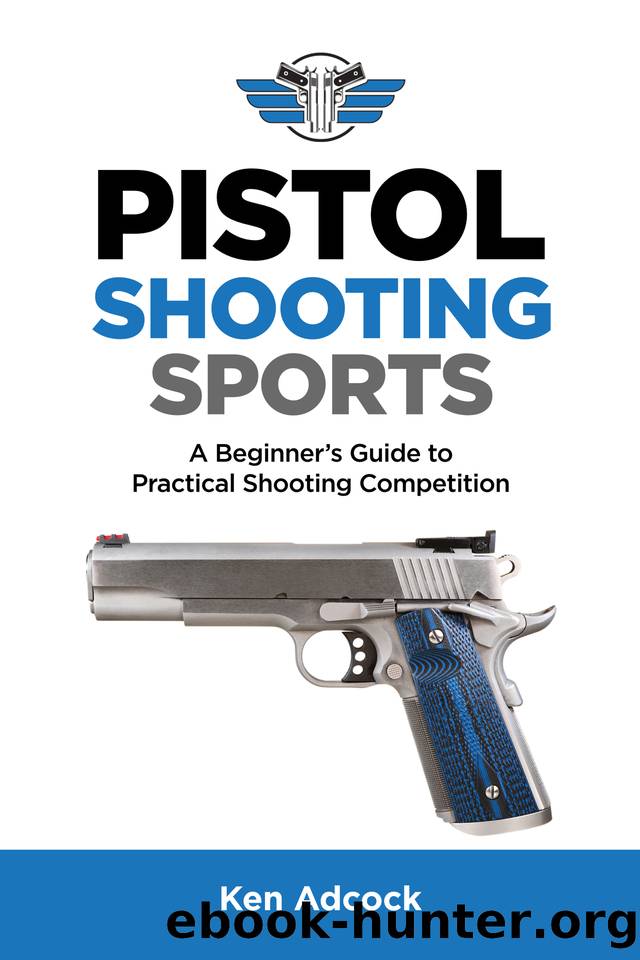Pistol Shooting Sports: A Beginner's Guide to Practical Shooting Competition by Adcock Ken

Author:Adcock, Ken [Adcock, Ken]
Language: eng
Format: epub
Publisher: Pistol Shooting Sports, LLC
Published: 2021-01-03T16:00:00+00:00
Chapter 32
Safety Violations and Disqualification
You are expected to understand how to be safe and how to keep everyone else safe by following competition and range-specific rules at all times. This includes ensuring control of your firearm at all times as you move about the range and compete on stages.
SAFETY VIOLATIONS
When an appointed range officer observes a âsafety violation,â they will issue the âSTOPâ command. The RO will instruct competitors to ensure their gun and the range is safe before discussing the safety issue. In the case of a dropped gun, the range officer will instruct everyone on how to proceed before the firearm is retrieved safely.
When the range is safe, the match director will usually be called to review the range officer's observation and ensure the competitor understands the violation. The match director will make a decision around disqualification based on the official rules and what the appointed RO observed. It is important to remember that the range officer and match director are there to ensure everyone understands and follows safe rules of competition.
Examples of safety violations include:
Accidental discharge (AD) - The gun goes off without intention, not pointed at an intended target.
Unsafe gun handling - The manipulation of a firearm that causes, or could cause, an unsafe condition. (Types of unsafe gun handling violations below.)
Handling a firearm outside the designated safety area - This refers to removing a firearm from a holster or bag outside the safety area, when a range officer has not issued the command to do so.
Handling any ammunition inside the safety area - Any handling of loaded magazines, live or dummy ammunition, when inside the safety area.
Unsafe finger placement or riding the trigger - Resting your finger on the trigger when you are not engaging a target is a quick way to get disqualified. Keep your finger outside the trigger guard until you are ready to fire.
Sweeping - Inadvertently pointing the muzzle of the gun at an arm, leg, body part, or person. Always be aware of where your arms, legs, and the range officers are in relation to where the gun is pointed. Keep the muzzle of the gun out in front of you and pointed in a safe direction.
Breaking the 180 rule - Each course of fire is designed to be engaged safely. Pointing a gun anywhere but downrange is not part of the course of fire. Breaking the 180-degree plane means you have pointed the gun away from the designated shooting area. This can happen when competitors are on the move and not aware of the direction they are facing. Be mindful as you move from location to location, or when clearing a malfunction, that your gun is purposefully pointing downrange.
Download
This site does not store any files on its server. We only index and link to content provided by other sites. Please contact the content providers to delete copyright contents if any and email us, we'll remove relevant links or contents immediately.
Backpacker the Complete Guide to Backpacking by Backpacker Magazine(1815)
The Isle of Mull by Terry Marsh(1517)
Capital in the Twenty-First Century by Thomas Piketty(1418)
Predation ID Manual by Kurt Alt(1311)
The Collected Non-Fiction by George Orwell(1306)
Small-Bore Rifles by C. Rodney James(1270)
Creative Confidence by Tom Kelley(1140)
Backcountry Bear Basics by Dave Smith(1128)
All Fishermen Are Liars by John Gierach(1111)
50 Famous Firearms You've Got to Own by Rick Hacker(1101)
Blood Mountain by J.T. Warren(1089)
The Art of Throwing by Amante P. Marinas Sr(1076)
Archery: The Art of Repetition by Simon Needham(1065)
Long Distance Walking in Britain by Damian Hall(1050)
Backpacker Long Trails by Backpacker Magazine(1031)
The Fair Chase by Philip Dray(979)
The Ultimate Shooting Skills Manual: 212 Essential Range and Field Skills (Outdoor Life) by The Editors of Outdoor Life(963)
The Real Wolf by Ted B. Lyon & Will N. Graves(956)
The Ultimate Guide to Home Butchering by Monte Burch(948)
